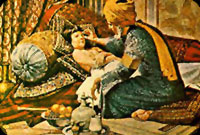
|
The
history of medicine in Iran is as old and as rich as its civilization. In
the Avesta, science and medicine rise above class, ethnicity, nationality,
race, gender and religion.
Some of the earliest practices of ancient Iranian medicine have been
documented in the Avesta and other Zoroastrian religious texts.
During the Achaemenid era (559-330 BCE), the 21 books of Avesta
encompassing 815 chapters were an encyclopedia of science consisting of
medicine, astronomy, law, social science, philosophy, general knowledge,
logic and biology.
It can be inferred from these books that Zoroastrians placed great
importance on personal hygiene, public health and the prevention of
contagious diseases.
The best teachers of medicine and astrology were Iranian Magi and Mobeds
(Zoroastrian priests) who passed their knowledge on to their pupils from
one generation to the next.
According to Avestan texts, King Jamshid was the physician who initiated
the custom of bathing with hot and cold water.
Iranians refrained from polluting the four elements. They would not bathe
or wash dirty objects in flowing water, and urinating or spitting into
water was considered a great sin.
Odorous materials were never thrown into the fire. Wild rue and
frankincense were always burned inside houses to kill insects and
bacteria, a custom which continues to this today.
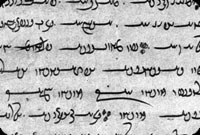
Pahlavi text
|
The Persians, who lived in an empire stretching from the Indus valley in
the east to the Aegean Sea in the west with considerable variation in
climate and vegetation, became familiar with a vast range of medicinal
plants.
The Avesta mentions several medicinal herbs including basil, chicory,
sweet violet, and peppermint, while Bundahishn cites the names of thirty
sacred medicinal plants.
Avestan texts list not only the various parts of plants such as roots,
stems, scales, leaves, fruit and seeds used for treatment but also
indicate which plant is the remedy for each disease.
According to the Z‚dspram, a Pahlavi text of the ninth century AD, there
are thousands of species of medicinal plants created by Ahura Mazda for
the prevention of thousands of sicknesses created by Ahriman and that the
best of these plants is haoma (Vedic soma).
Haoma (Ephedra Vulgaris) is indigenous to the Iranian plateau and contains
a large quantity of Ephedrine which is effective in the treatment of
cardiovascular and respiratory diseases.
Garlic was used to reduce blood pressure, combat heart disease and treat
infections.
Rue was once a popular remedy for earache, easing shaking fits and joint
pain; it was also used to disinfect the house.
Bangha, extracted from Cannabis Indica seeds, has hallucinatory effects
and was used as an anesthetic.
Frankincense was used for inhalation therapy.
Aloeswood was used in the treatment of cardiac disease and irregular
heartbeat.
Many modern-day Iranian herbalists use reference books inherited from
generations past, and still prescribe plants such as Borage, Sweet
Marjoram, Fenugreek and Chicory as treatment.
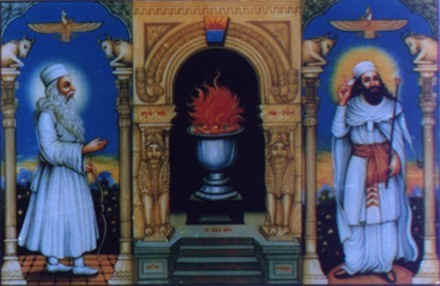
|
Ancient Persian physicians believed that good health is the result of the
'right' measure of the elements of humor, and that sickness is the product
of their excess or deficiency.
Therefore, the medicine of the body consists of keeping the body in good
health and re-establishing balance and the medicine of the soul involves
curing the body and preserving it from sin.
The Vendidad tells of three kinds of medicine practiced; medicine by the
knife (surgery), medicine by herbs, and medicine by divine words, which
according to the sacred text, is the best form of the three.
A Mazdean physician-in-training was required to treat and cure three non-Mazdean
patients before receiving permission to treat Mazdeans.
In this way physicians were taught to treat any and all patients, whether
friend or foe. Avestan scriptures did not restrict giving treatment to
Mazdeans alone.
The Ordibehesht Yasht classifies physicians under five categories:
1 - Health Physician (Ashoo Pezeshk)
This physician was in charge of the well-being of the city, preventing the
spread of contagious diseases by quarantining, keeping the four sacred
elements of water, wind, earth and fire free from contamination, and
making sure the sanitation of houses was maintained.
2 - Medical Examiner (D‚d Pezeshk)
Similar to modern-day pathologist/coroners, their duties included
examining the dead, performing autopsies when required, the issuance of
burial licenses and ascertaining the cause of death with an eye toward
finding cures for future cases.
3- Surgeon (Kard Pezeshk)
Archeological excavations in the Burnt City in Sistan have yielded skulls
that show signs of surgery. Surgical procedures, difficult and dangerous
even in the present time, were much more so in the past when it was not
possible to properly anaesthetize patients and medical instruments were
rudimentary.
4 - Herbalist (Gy‚h Pezeshk)
The origin of herbal medicine predates the development of agriculture and
cultivation in Iran, yet some believe that the ancient Persians were the
first to document the properties of herbs and to use plants to cure
diseases.
5- Psychiatrists (Mantreh Pezeshk)
This physician used holy words and prayers to cure patients suffering from
a sickness of body and soul which could not be cured with herbs.
Treatment consisted of verbal communication, the reading of poetry,
listening to music and the recitation of prayers, including ones from the
holy books of other nations, which were designed to console and heal the
patient.
Avestan texts tell of consultation among the surgeons, herbalists and
psychiatrists which indicates a form of medical association at the time.
Referring to a foreign physician when a Persian one was at hand was
considered a sin, and a physician's fee for service was based on the
patient's income while the fee for treating a priest was his pious
blessing.
The first physician as documented by Avestan texts was Vivangahan,
followed by Abtin, Atrat and Purshaspa.
Mani, Roozbeh, and Bozorgmehr are among the other notable Persian
physicians named in the Avesta.
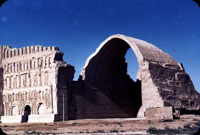
Ruins of Ctesiphone Palace
|
Credit for the establishment of hospital and training system must be given
to the ancient Persians, as they founded the first teaching hospital in
Gundishapur where medical students practiced on patients under the
supervision of physicians.
The international university, founded in 271 AD by Shahpour I, was a
center of learning and study in the fields of science and medicine.
The age-old school is still a center of knowledge in Khuzestan Province in
southwestern Iran.
Gundishapur, mentioned in Ferdowsi's (935 - 1020 AD) eternal epic
Shahnameh (Book of Kings), was located near the city of Susa.
It was an important cultural and scientific center of the Sassanid era
(226 - 652 AD) and scholars from various countries, one of whom was
Diogenes, studied different fields including medicine at the university.
The library of the university known as the 'city of Hippocrates' consisted
of eight floors and 259 halls containing an estimated 400,000 books.

Map of the Sassanid empire
|
The university was a gathering place for great scientists and physicians
from all civilizations of the ancient world, a breeding ground for ideas
and innovations.
Medical science, anatomy, dentistry, astronomy, mathematics, philosophy,
military command, architecture, agriculture and irrigation were taught in
Greek or Syriac and later Pahlavi in the school.
Gundishapur physicians were required to pass special examinations to
obtain a license for practicing medicine.
This well-organized medical institute was operated by a director, medical
staff, pharmacists and servants, and upon its portal was engraved
"knowledge and virtue are superior to sword and strength."
The Sassanid ruler Khosrow Anushiravan (531 - 578 AD) who took an interest
in the school and the advancement of medicine sent the Iranian physician
Burzuyah to India to obtain medical and scientific books and translate
them into the Pahlavi language.
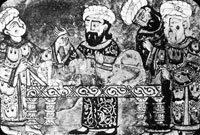
Physicians examining a patient
|
In 550 AD, the world's first medical conference was held on Anushiravan's
order in Ctesiphon. Hundreds of Mobeds and physicians from Persia and
other countries attended this congress, a historical event which Ferdowsi
versified in Shahnameh.
Gundishapur scholars and graduates were appointed to important
governmental positions. The minister of health (Iran Dorostbod) was chosen
from among the best physicians, and the minister of education (Iran
Farhangbod), was an accomplished scholar of philosophy, logic, mathematics
or psychology.
Iranian medicine, which combined medical traditions from Greece, Egypt,
India and China for more than 4000 years, became the foundation of the
medical practices of European countries during the 13th century.
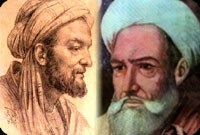
Avicenna (L) and Alfarabius (R)
|
Among the torchbearers of ancient Persia's scientific heritage are
Mohammad Zakaria Razi, Abu Nasr Farabi, Omar Khayyam and Avicenna, who
used this knowledge to make further discoveries of benefit to all
humankind.
Razi, known in the West as Razes (865-925 AD), considered the father of
pediatrics and a pioneer of neurosurgery and ophthalmology, discovered and
refined the use of ethanol in medicine.
Farabi also known in the West as Alfarabius (872-951 AD), is noted for his
contributions to psychology. He wrote the first treatises on social
psychology.
Avicenna (980-1037 AD), a prolific genius, introduced systematic
experimentation into the study of physiology, experimental medicine,
evidence based medicine, clinical trials, risk factor analysis, the idea
of a syndrome and contributed to clinical pharmacology and
neuropsychiatry.
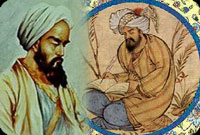
Razes (L) and Khayyam (R)
|
Khayyam (1048-1131 AD) was a renowned astronomer who contributed to
mathematics and calendar reform.
These outstanding scholars are among the many whose names will forever
shine in the history of medicine and science and will always be revered by
the Iranian people.
|







